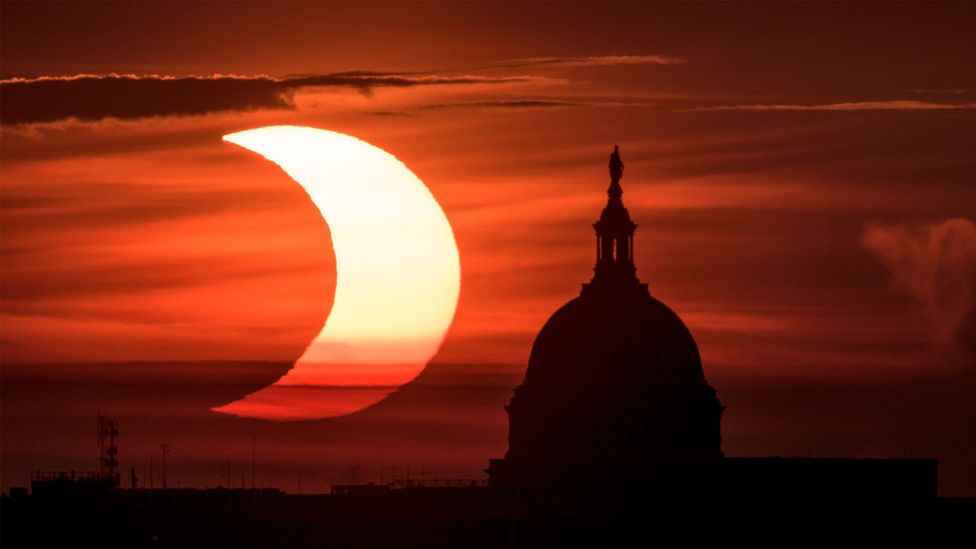On Monday 8 April, millions of people across North America are set to witness one of the rarest of treats – a total solar eclipse.
From the Pacific coastal city of Mazatlán in Mexico to the Eastern coast of Canada's Newfoundland, the Moon will perfectly block the Sun and cast its shadow on the ground, turning day to near-night. But it's not just the public set to be enthralled, as scientists race to prepare experiments to observe this magnificent event.
Every 18 months, a total solar eclipse occurs somewhere on Earth, a fortuitous quirk of the Sun being 400 times further from Earth than the Moon and 400 times larger, making the disc of the Moon entirely cover the solar disc when it perfectly aligns between Earth and the Sun. This April eclipse is of particular note, however, because of the vast amount of populated land the eclipse will pass over, allowing many millions of people to watch.
Locations in the path of totality will be plunged into darkness for no more than four minutes, but that is enough to perform some of the rarest of science experiments, with scientists hoping to observe the Sun's atmosphere – its corona – as it dances around the Moon, the reaction of wildlife to the celestial event, and even launching rockets to observe how Earth's atmosphere reacts.
An estimated 31 million people will be in the path of the eclipse, double that of the last total solar eclipse that crossed the US on 21 August 2017. Totality is also longer this time around, up from two and a half minutes for most observers in 2017 because the Moon was further away from Earth. This eclipse path will also be almost twice as broad (nearly 200km wide [120 miles] versus just 110km [70 miles] in 2017).
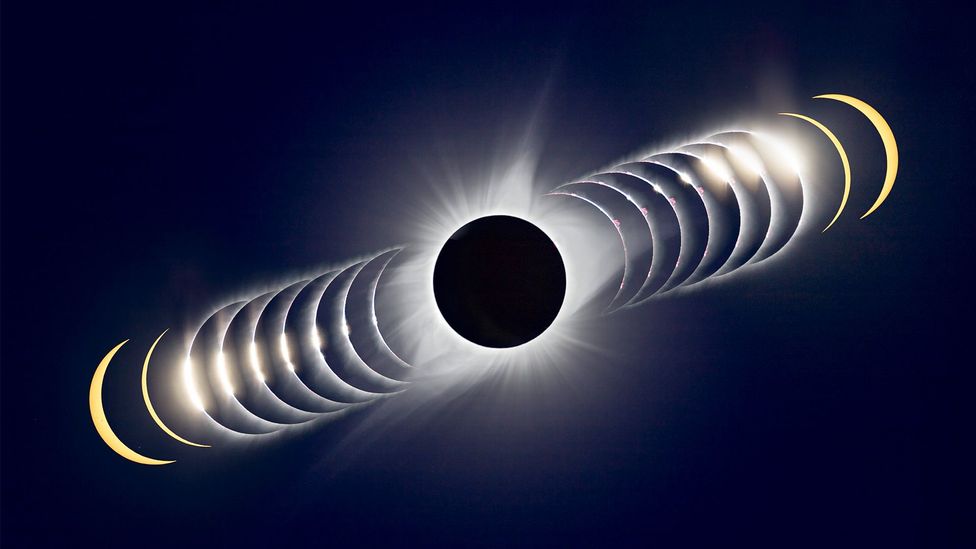
Scientists are excited because this eclipse will pass over much more heavily populated land than the one which crossed the US in 2017 (Credit: Getty Images)
Adam Hartstone-Rose from NC State University in North Carolina is leading a project to study how wildlife reacts to the eclipse. In 2017 he had teams of researchers stationed at different zoos in the path of totality to watch how animals behaved. Some were baffled – a group of gorillas trooped inside for their evening meal as darkness fell, but were left empty-handed as daylight returned. "The giraffes were my favourite," says Hartstone-Rose. "Somebody had reported wild giraffes in Africa started galloping during a total eclipse. I was really sceptical because giraffes are pretty passive animals. Despite my scepticism, some of them started running around."
The "most crazy behaviour", says Hartstone-Rose, was a group of Galapagos tortoises. "As totality grew, they became more and more active," he says. "Right at the peak of totality, they started mating, which we cannot explain. Maybe it was as one-time thing. We're going to be watching more tortoises this time around."
Hartstone-Rose will have researchers stationed at Fort Worth Zoo in Texas to monitor more than 20 species of animals during the eclipse, including gibbons, flamingos, orangutans, and, of course, tortoises. He is also asking members of the public to perform their own animal behaviour studies, either observing pets or nearby wildlife, and upload their observations online.
All animals are of interest, from dogs to farm animals. "There's very little information about what farm animals do," says Hartstone-Rose. "Are cows going to come towards the barn during totality? Shouldn't roosters crow sometime during an eclipse?"
Animals react to the change in light, sometimes very strongly – Trae Winter
Hartstone-Rose isn't the only person who will be studying how animals behave during the eclipse. Trae Winter at the Advanced Research in Inclusion and Steam Accessibility (Arisa) Lab in Massachusetts will lead Nasa's Eclipse Soundscapes project, which will be using small phone-sized devices equipped with microphones, called AudioMoths, to listen to the sounds of nearby animals. Hundreds of volunteers will place the devices along the path of totality, allowing Winter and his team to hear how different animals react to both the drop in light during totality and the associated drop in temperature of some 10F (5.5C).
"Animals react to the change in light, sometimes very strongly, and also temperature changes," says Winter. "It's a multi-sensory experience." A range of animals will be studied such as crickets and even humans. "I'm looking forward to listening to a lot of humans experiencing an eclipse for the first time and the sounds of excitement they make," says Winter. That's something Hartstone-Rose is interested in too. "The strangest animal behaviour we observed in 2017 was the people around us," he says. "People started hooting and hollering or lying down on the concrete."
Not everyone studying the eclipse will actually get to witness it. As the Moon crosses the Sun, Aroh Barjatya at Embry Riddle Aeronautical University in Florida will be hundreds of kilometres from totality at Nasa's Wallops Flight Facility in Virgina. Here, he'll be busy with an extremely unique experiment called Atmospheric Perturbations around Eclipse Path (Apep) – launching three 18m-tall (59ft) rockets, called sounding rockets, into the atmosphere at the time of the eclipse to monitor changes in the planet's atmosphere. "The professional side of me is very excited," says Barjatya. "The personal side of me is slightly sad to be missing out on totality."
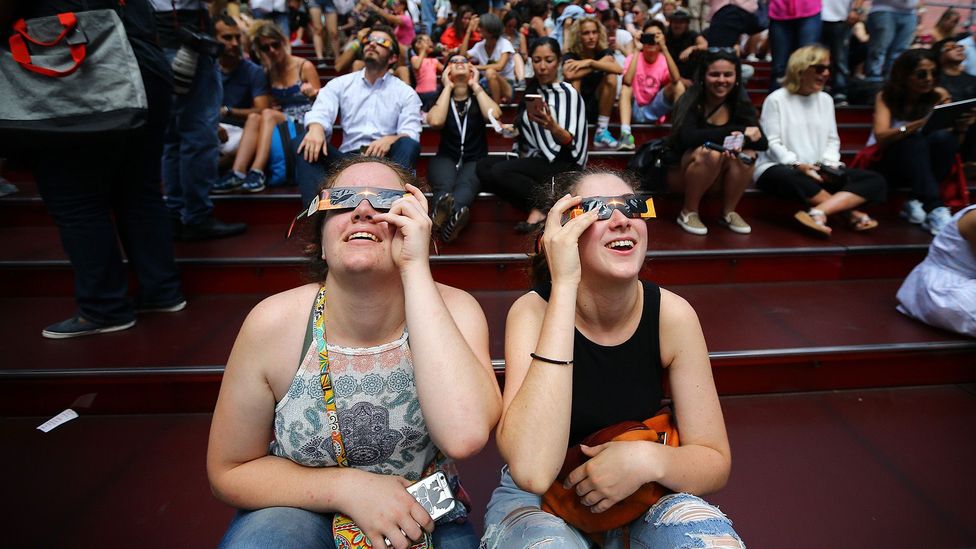
An estimated 31 million people will be in the path of the eclipse, double that of the last total solar eclipse in 2017 (Credit: Getty Images)
The scientific returns on offer should allay some of Barjatya's disappointment. Each rocket will launch up to an altitude of about 420km (260 miles) before falling back to Earth. One rocket will be launched 45 minutes before the peak eclipse, one during, and one 45 minutes after. Instruments on board will measure charged particles and electric and magnetic fields in the ionosphere, a region of Earth's atmosphere that extends from 100km to 1,000km (62 miles to 620 miles) above the planet's surface, and how that changes in response to the eclipse. Fluctuations in the ionosphere outside of an eclipse can affect satellite communications, so an eclipse gives a rare opportunity to study these changes in greater detail.
As the Moon's shadow passes over, it's expected that the density of the ionosphere will drop, reacting to the passing shadow in ripples. "It's like a motorboat on a lake," says Barjatya. Flying so high allows for a much more precise measurement of the ionosphere to be made during the eclipse than is possible on the ground. "Ground-based observations have a very large resolution, at best a kilometre or two," says Barjatya. "What the rockets help us do is look at sub-metre resolution, sometimes under a centimetre. So you are able to see the smallest level of fluctuations, which create radio frequency interruptions."
The hope is that the megamovie will reveal features of the Sun's corona
On average any given location on Earth only sees an eclipse once every 375 years, meaning this eclipse will not only be watched but photographed by many witnessing the historic event. Laura Peticolas at Sonoma State University in California is asking anyone that does so to get involved in her Eclipse Megamovie project, which will seek to stitch together hundreds of images from observers into a single movie of totality.
Peticolas ran the same project in 2017 but noted it "wasn't as beautiful as we were imagining in our minds" because of a lack of imagery. So this time around, they will be hoping for a much wider pool of images, including better professional images of the eclipse, to produce a more polished product. The hope is that the megamovie will reveal features of the Sun's corona, such as jet-like ejections of hot plasma firing around the Moon, evolving as different people along the path take images.
"This time we're really expecting to be able to find those jets and features that are changing," she says. Ordinarily such events are extremely hard to study, except for specially designed telescopes or spacecraft that can block out the Sun, but a total solar eclipse allows many more observers to do so. This event should be particularly noteworthy because the Sun is heading towards its period of peak activity, called solar maximum, that takes place in an 11-year cycle for reasons that are still not fully understood.
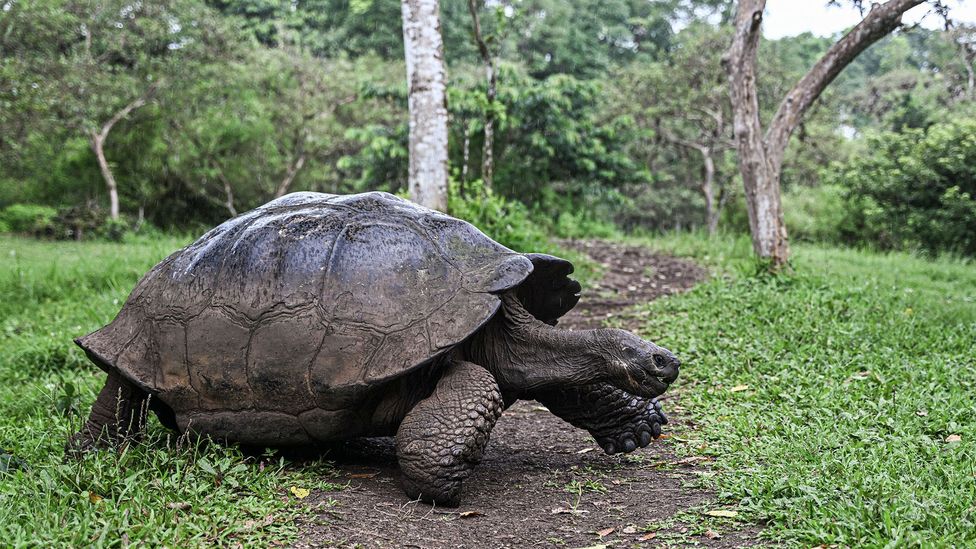
In 2017, giant Galapagos tortoises reacted dramatically to the eclipse –seeing it as a cue to mate (Credit: Getty Images)
"This is going to be a much bigger eclipse in terms of people heading towards the path of totality," says Peticolas. "This project really capitalises on that. I'm hoping for like 500 volunteers to upload images."
For many people on the ground, the weather could play a crucial factor in whether they can actually see totality or not, with cloud cover always threatening to spoil the view of the sun. One way to avoid that is to take to the skies, something Nasa will be doing with two of its WB-57 planes. Flying at 50,000ft (15km), the planes will follow the path of totality off the coast of Mexico, experiencing about seven minutes of darkness, and will be equipped with instruments to study the Sun.
Leading one of the experiments is Amir Caspi at the Southwest Research Institute in Colorado, who will be using an infrared camera on board one of the planes – although he won't be flying himself – to study the solar corona. One of the key mysteries of the corona is that it reaches millions of degrees in temperature, compared to just 5,000C (9,000F) for the surface of the Sun, for reasons that can't fully be explained.
More like this:
- The odd ways eclipses affect radio waves
- If you think an eclipse means doomsday, you're not alone
- What if one rogue nation blocked the Sun?
- Where and how to watch the solar eclipse in North America
Caspi thinks there may be a link between ejections of plasma from the Sun, called prominences, essentially a "blob of plasma that has bubbled up from the surface", and the corona itself. These prominences are up to 30,000C (54,000F), much cooler than the corona, but can emit as brightly in infrared. "We're trying to answer what is contributing to this emission," says Caspi. "They can't be the same mechanism because of this huge difference in temperature." One answer might lie in how magnetic fields twist and turn above the Sun's surface.
If rockets and planes aren't enough, Angela Des Jardins at Montana State University will be leading 53 teams of students across the US that will send about 600 balloons into the atmosphere as part of the Nationwide Eclipse Balloon Project. Rising up to 115,000ft (35km), the balloons will use instruments to see how both Earth's atmosphere and its weather react to the changing conditions of the eclipse.
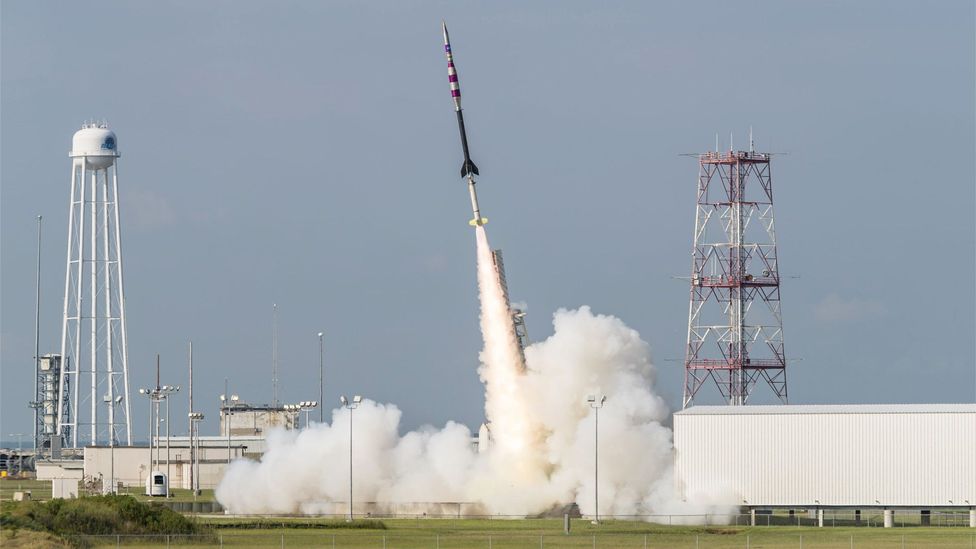
Sounding rockets will be used to test changes in the Earth's atmosphere during the eclipse (Credit: Nasa)
Some of the instruments will study gravity waves, pressure waves moving through the atmosphere as a result of the changing temperature. "It's like a rock thrown in a pond and it creates waves," says Des Jardins. Others will measure humidity, wind direction and windspeed to monitor any changes caused by the eclipse. "Having 600 balloons that are flying and measuring the atmosphere is such a wonderfully rich data source," says Des Jardins. "We're expecting at least a dozen papers to be published as a result of the data we collect." There will even be some cameras on board that will live stream the eclipse down to the ground.
The expectation this time around is that, while the 2017 US total solar eclipse whet the appetite for the public and scientists alike, 2024 will be a much-more-widely watched and studied event because of the amount of ground it will cover and the knowledge of what to expect this time around.
"I think people are more excited about this," says Hartstone-Rose. "2017 was unexpectedly cool. 2024 is going to be over a more populated part of America and even more beautiful because the Sun is in this amazing cycle of ejection. The corona is going to be really fantastic."
--
If you liked this story, sign up for The Essential List newsletter – a handpicked selection of features, videos and can't-miss news delivered to your inbox every Friday.
